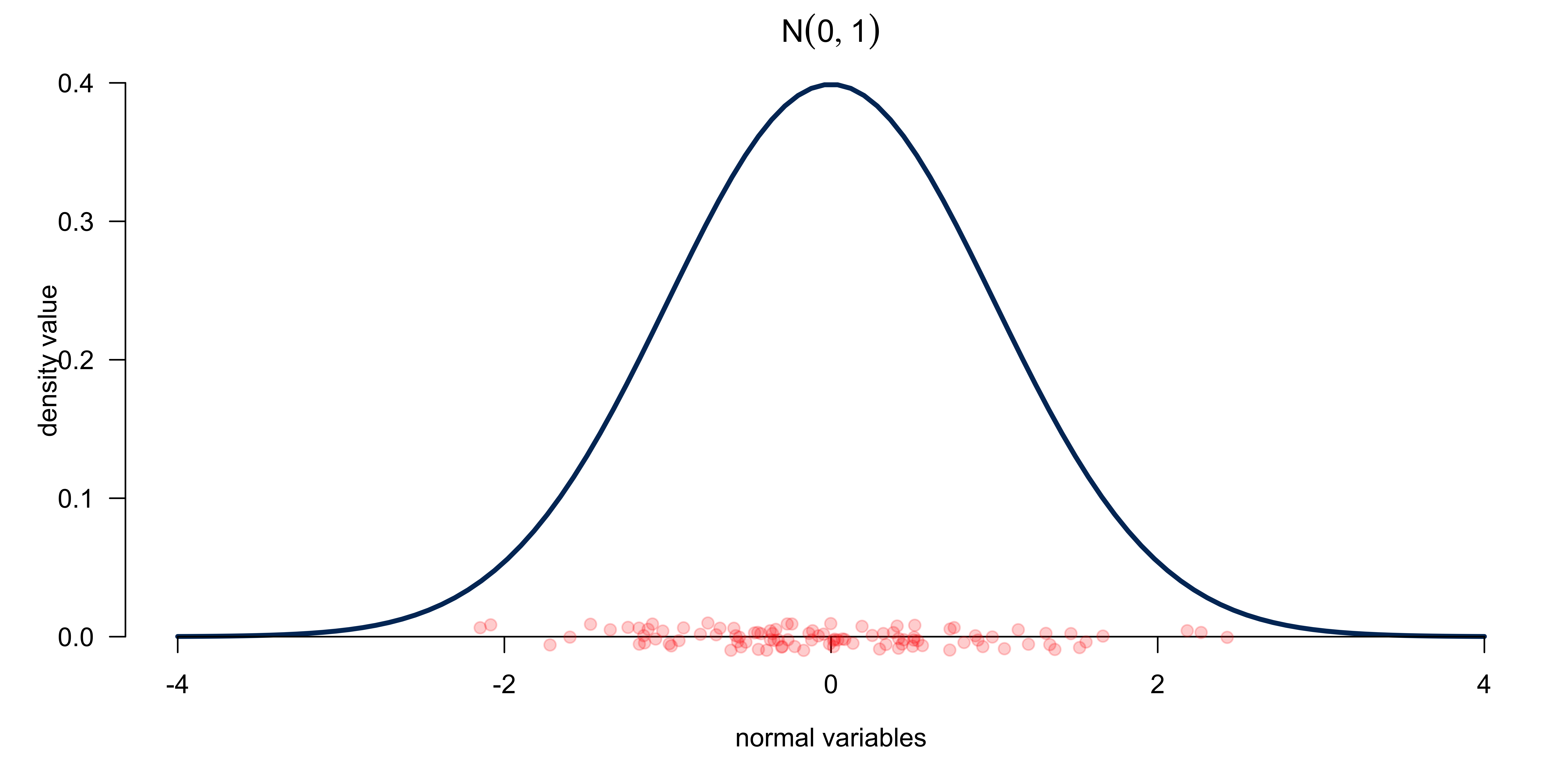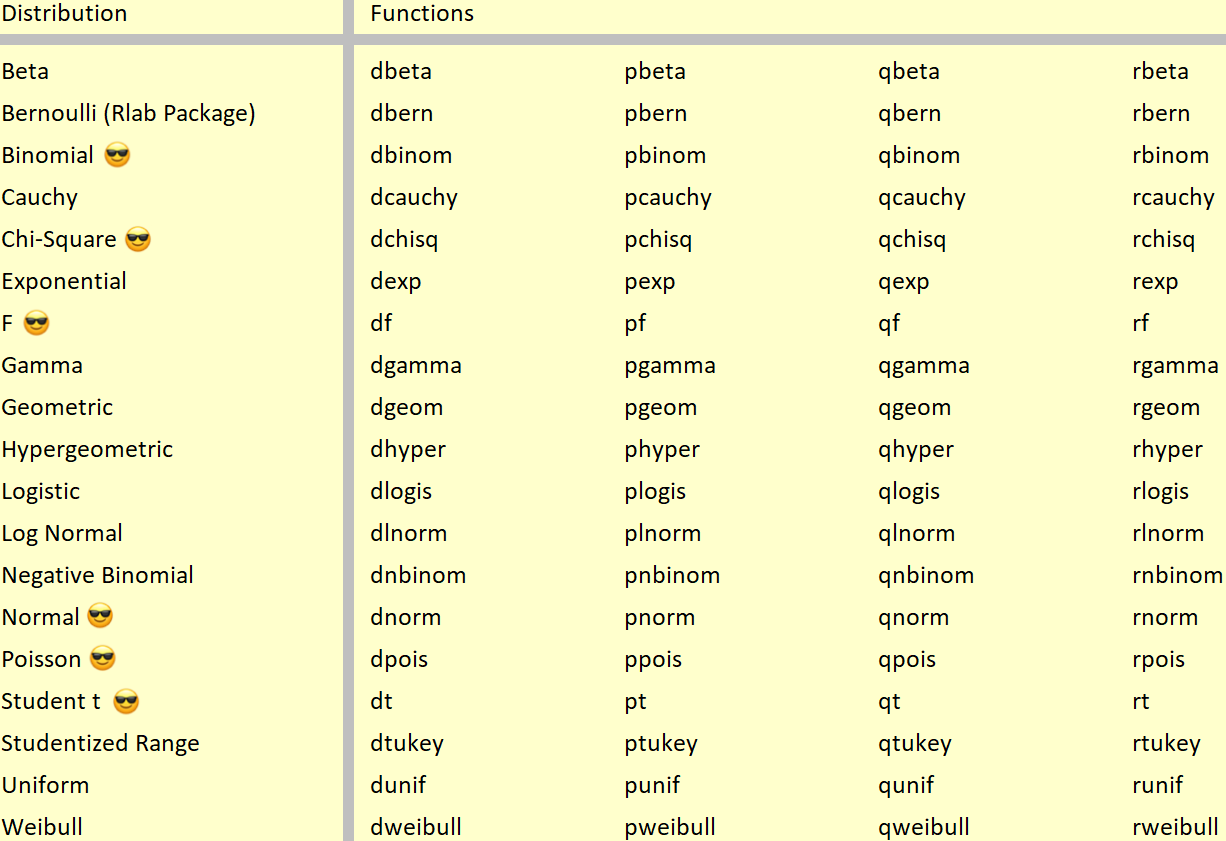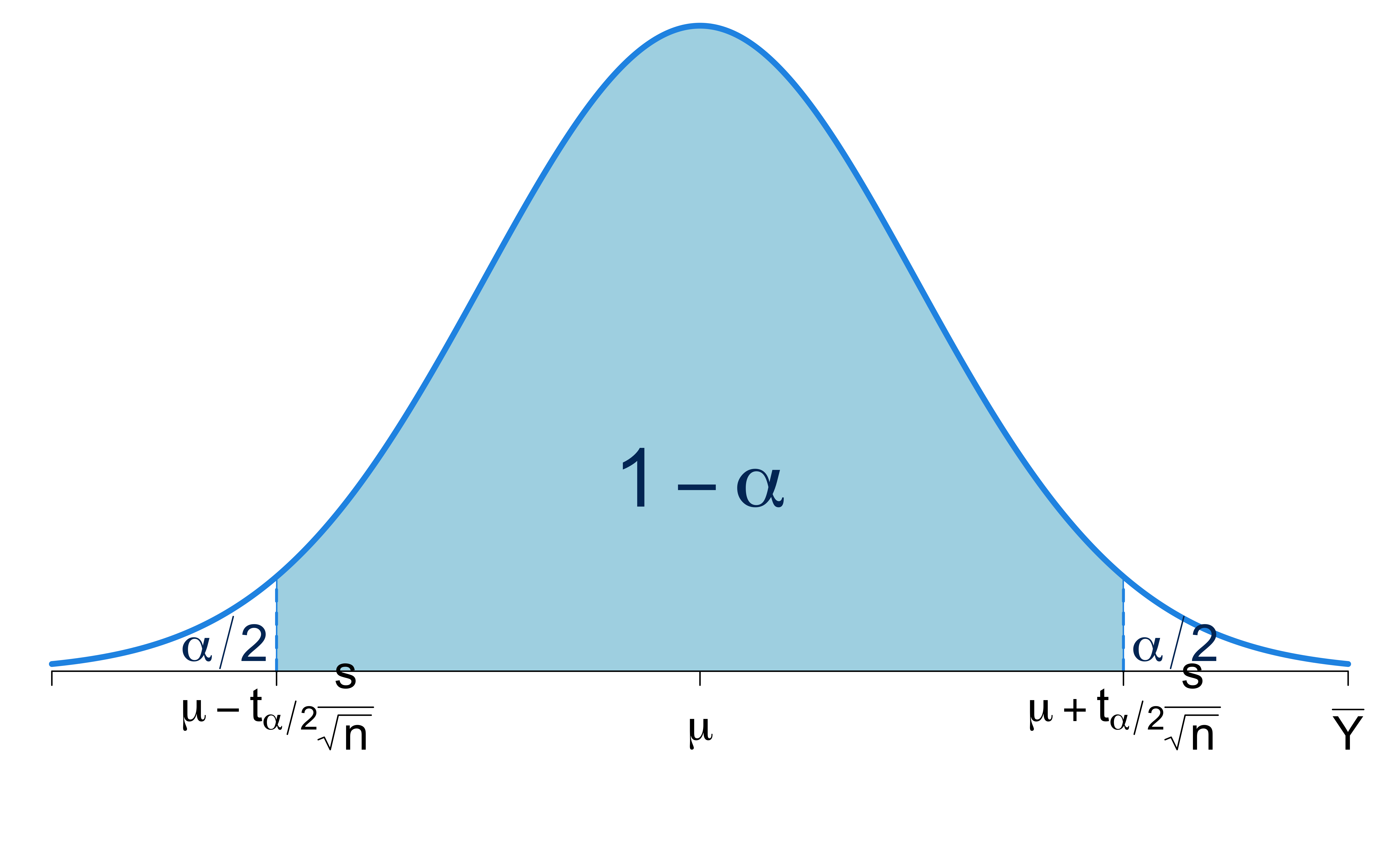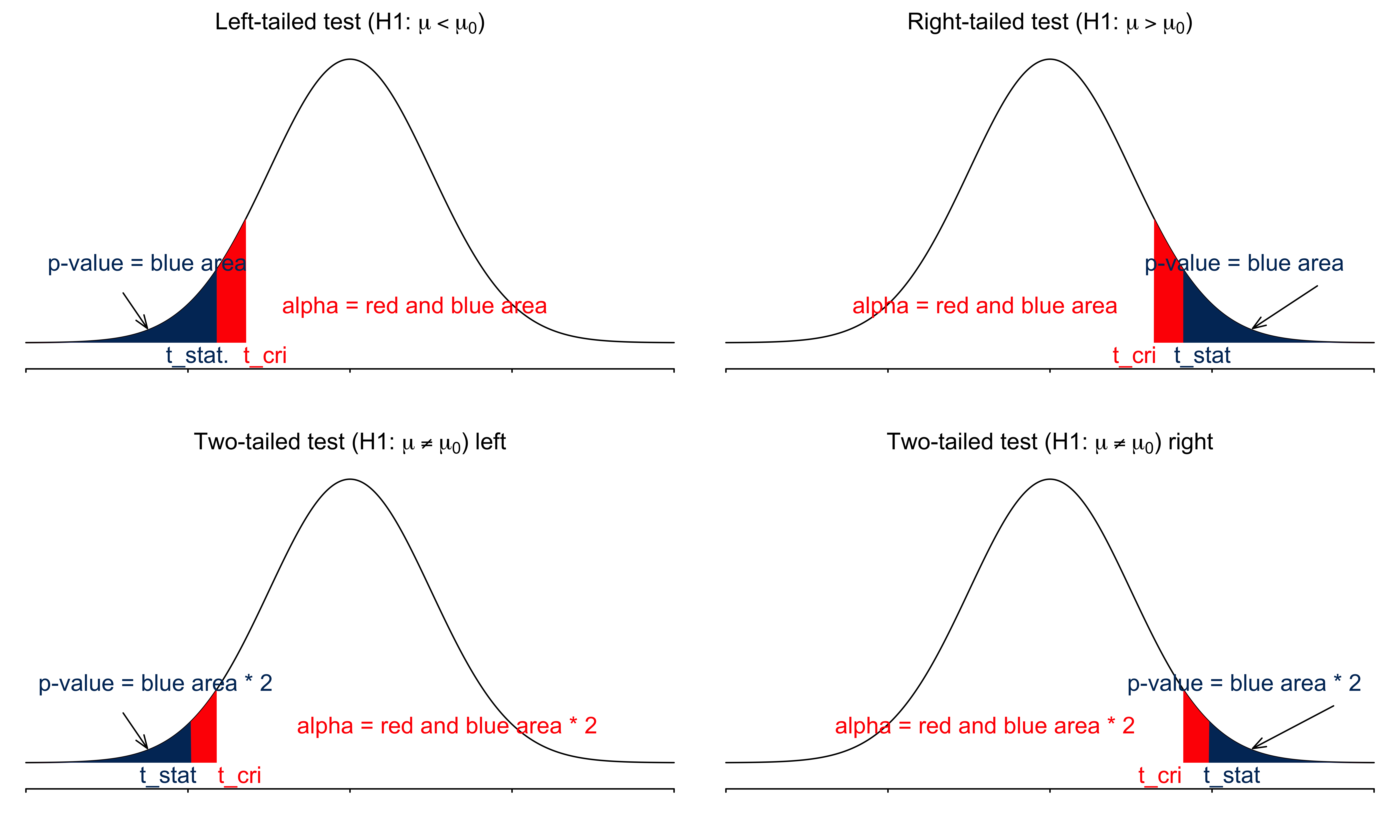[1] 2 2 2 2 2 2 0 1 3 3[1] 0.23MATH 4780 / MSSC 5780 Regression Analysis
A discrete variable \(Y\) has countable possible values, e.g. \(\mathcal{Y} = \{0, 1, 2\}\)
Probability (mass) function (pf or pmf) \[P(Y = y) = p(y), \,\, y \in \mathcal{Y}\]
\(0 \le p(y) \le 1\) for all \(y \in \mathcal{Y}\)
\(\sum_{y \in \mathcal{Y}}p(y) = 1\)
\(P(a < Y < b) = \sum_{y: a<y<b}p(y)\)
Give me an example of a discrete variable/distribution!
\(P(Y = y; m, \pi) = \frac{m!}{y!(m-y)!}\pi^y(1-\pi)^{m-y}, \quad y = 0, 1, 2, \dots, m\)
A continuous variable \(Y\) has infinite possible values, e.g. \(\mathcal{Y} = [0, \infty)\)
Probability density function (pdf) \[f(y), \,\, y \in \mathcal{Y}\]
\(f(y) \ge 0\) for all \(y \in \mathcal{Y}\)
\(\int_{\mathcal{Y}}f(y) \, dy= 1\)
\(P(a < Y < b) = \int_{a}^bf(y)\,dy\)
Give me an example of continuous variable/distribution!
For continuous variables, \(P(a < Y < b)\) is the area under the density curve between \(a\) and \(b\).
For a random variable \(Y\),
The expected value or mean: \(E(Y)\) or \(\mu\).
The variance: \(\mathrm{Var}(Y)\) or \(\sigma^2\).
The mean measures the center of the distribution, or the balancing point of a seesaw.
The variance measures the mean squared distance from the mean, or dispersion of a distribution.
Discrete \(Y\):
\[E(Y) := \sum_{y \in \mathcal{Y}}yP(Y = y)\] \[\begin{align} \mathrm{Var}(Y) &:= E\left[(Y - E(Y))^2 \right] \\&= \sum_{y \in \mathcal{Y}}(y - \mu)^2P(Y = y)\end{align}\]
Continuous \(Y\):
\[E(Y) := \int_{-\infty}^{\infty}yf(y)\, dy\] \[\begin{align} \mathrm{Var}(Y) &:= E\left[(Y - E(Y))^2 \right] \\&= \int_{-\infty}^{\infty}(y - \mu)^2f(y)\, dy \end{align}\]
This is NOT the sample mean \(\overline{y}\) or sample variance \(s^2\).
For some distribution (dist),
dist(x, ...): density value \(f(x)\) or probability value \(P(X = x)\).dist(q, ...): cdf \(F(q) = P(X \le q)\).dist(p, ...): quantile of probability \(p\).dist(n, ...): generate \(n\) random numbers.

What is the distribution of \(a_1Y_1 + a_2Y_2 + \cdots + a_nY_n\) if \(Y_i \sim N(\mu_i, \sigma^2_i)\) and \(Y_i\)s are independent?
Suppose each data point \(Y_i\) of the sample \((Y_1, Y_2, \dots, Y_n)\) is a random variable from the same population whose distribution is \(N(\mu, \sigma^2)\), and \(Y_i\)s are independent each other: \[Y_i \stackrel{iid}{\sim} N(\mu, \sigma^2), \quad i = 1, 2, \dots, n\]
If \(Y_i \stackrel{iid}{\sim} N(\mu, \sigma^2), \quad i = 1, 2, \dots, n\),
\(\overline{Y} \sim N\left(\mu,\frac{\sigma^2}{n} \right)\)
\(Z = \frac{\overline{Y} - \mu}{\sigma/\sqrt{n}} \sim N(0, 1)\)
Let the sample variance of \(Y\) be \(S^2 = \frac{\sum_{i=1}^n(Y_i - \overline{Y})^2}{n-1}\).
\(\frac{\overline{Y} - \mu}{S/\sqrt{n}} \sim t_{n-1}\)
\(X_1, X_2, \dots, X_n\) are i.i.d. variables with mean \(\mu\) and variance \(\sigma^2 < \infty\).
As \(n\) increases, the sampling distribution of \(\overline{X}_n = \frac{\sum_{i=1}^nX_i}{n}\) looks more and more like \(N(\mu, \frac{\sigma^2}{n})\), regardless of the distribution from which we are sampling \(X_i\)!
Nature Methods 10, 809–810 (2013)
\[\small \begin{align} & \quad \quad P(-t_{\alpha/2, n-1} < T < t_{\alpha/2, n-1}) = 1 - \alpha \\ & \iff P(-t_{\alpha/2, n-1} < \frac{\overline{Y} - \mu}{S/\sqrt{n}} < t_{\alpha/2, n-1}) = 1 - \alpha \\ & \iff P(\mu-t_{\alpha/2, n-1}S/\sqrt{n} < \overline{Y} < \mu + t_{\alpha/2, n-1}S/\sqrt{n}) = 1 - \alpha \end{align}\]
\[P\left(\mu-t_{\alpha/2, n-1}\frac{S}{\sqrt{n}} < \overline{Y} < \mu + t_{\alpha/2, n-1}\frac{S}{\sqrt{n}} \right) = 1-\alpha\]
Is the interval \(\left(\mu-t_{\alpha/2, n-1}\frac{S}{\sqrt{n}}, \mu + t_{\alpha/2, n-1}\frac{S}{\sqrt{n}} \right)\) our confidence interval?

No! We don’t know \(\mu\), the quantity we’d like to estimate! But we almost there!
\[\begin{align} &P\left(\mu-t_{\alpha/2, n-1}\frac{S}{\sqrt{n}} < \overline{Y} < \mu + t_{\alpha/2, n-1}\frac{S}{\sqrt{n}} \right) = 1-\alpha\\ &P\left( \boxed{\overline{Y}- t_{\alpha/2, n-1}\frac{S}{\sqrt{n}} < \mu < \overline{Y} + t_{\alpha/2, n-1}\frac{S}{\sqrt{n}}} \right) = 1-\alpha \end{align}\]

Reject \(H_0\) if
| Method | Right-tailed \((H_1: \mu > \mu_0)\) | Left-tailed \((H_1: \mu < \mu_0)\) | Two-tailed \((H_1: \mu \ne \mu_0)\) |
|---|---|---|---|
| Critical value | \(t_{test} > t_{\alpha, n-1}\) | \(t_{test} < -t_{\alpha, n-1}\) | \(\mid t_{test}\mid \, > t_{\alpha/2, n-1}\) |
| \(p\)-value | \(\small P(T > t_{test} \mid H_0) < \alpha\) | \(\small P(T < t_{test} \mid H_0) < \alpha\) | \(\small 2P(T > \,\mid t_{test}\mid) \mid H_0) < \alpha\) |
